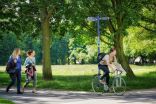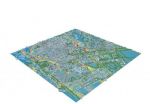Pollution dispersion in cities improved by trees, research shows
University of Leicester researchers show how trees benefit pedestrians in city environments
2015-09-03
(Press-News.org) Study examines trees in Leicester City
Pollution levels for pedestrians reduced by seven per cent in city environment
Highlights importance of trees in urban planning decisions
Trees in cities throughout the UK could be significantly improving the quality of the air we breathe by decreasing pollution levels for pedestrians, researchers from the University of Leicester have revealed.
The team from the University of Leicester's Department of Physics and Astronomy found that trees have a regionally beneficial impact by increasing turbulence and reducing ambient concentrations of road traffic emissions - by seven per cent in Leicester City at pedestrian height on average.
While previous studies have suggested that trees trap pollution by constructing wind flow in street canyons, the new study focuses on the effectiveness of trees at dispersing road traffic emissions on a city scale.
The study was supported by the Natural Environment Research Council (NERC), the University of Leicester and Bluesky International Ltd and is published in the journal Atmospheric Environment.
PhD researcher Antoine Jeanjean from the University of Leicester's Department of Physics and Astronomy who led the research said: "Predicting the concentration of air pollutants is essential for monitoring air quality in cities. We focused the study on the city centre of Leicester where you have a high density of buildings and traffic.
"Our fears of trees trapping pollution around streets were revealed to be unfounded. In some situation they can increase pollution locally but on average their impact is beneficial in terms of pollutants dispersion."
The study focused on the city of Leicester, where up to 90 per cent of some atmospheric pollutants such as NO2 are emitted by traffic.
The research team looked at ways trees could help to reduce air pollution in cities. To do this, they created a model with aerial mapping company Bluesky based on 3D representation of the city of Leicester with buildings, road and trees databases.
The study found that while trees reduced air quality in some street canyons in the city of Leicester by trapping pollution, they globally decrease the amount of pollutants around pedestrians within the city as a whole.
The researchers also found that while trees decrease the wind speed over the city, at the same time they produce more turbulence that helps in dispersing the pollution emitted by traffic, resulting in lower exposure for the public.
In addition to the increased dispersion of pollution by trees, there are also well known benefits of urban trees such as reduced stress, noise suppression and chemical and physical removal of certain pollutants.
Dr Roland Leigh from the University of Leicester's Department of Physics and Astronomy and a member of the University's Air Quality Group said: "The study highlights the importance of combining local and regional scale models for assessing the impact of trees in urban planning."
James Eddy, Bluesky's Technical Director and Industrial Associate at the University of Leicester added: "Basing this type of study on the most up to date and accurate geographic data, such as the National Tree Map, allows for the results to be validated and the studies replicated for other locations and types of environment further enhancing our understanding of air pollution and the important role played by trees."
Leicester City Council provided the buildings map and the University of Leicester's High Performance Computing services' ALICE supercomputer was used to run the modelling. The Bluesky National Tree Map (NTM) product was used to represent the trees.
INFORMATION:
The paper 'A CFD study on the effectiveness of trees to disperse road traffic emissions at a city scale' is published in the journal Atmospheric Environment and is available here: http://www.sciencedirect.com/science/article/pii/S135223101530248X
The paper can also be accessed at: doi:10.1016/j.atmosenv.2015.08.003
A video of Dr Roland Leigh discussing his research into air quality is available at: https://www.youtube.com/watch?v=MhM5M7vd4Dc
Images of pollution emitted by traffic over Leicester City and trees in the city available at: https://www.dropbox.com/sh/0cxd6r4b4h3x5bu/AAAndJ2OGpI2pY2xx3C0fdSta?dl=0
[Attachments] See images for this press release:


ELSE PRESS RELEASES FROM THIS DATE:
2015-09-03
In the first study of its kind, new research from the University of New Hampshire shows that crop rotations, in isolation from other management factors, can increase the functions performed by soil microbial communities that benefit plant growth. The study was conducted by researchers with the New Hampshire Agricultural Experiment Station.
The study was conducted by Lisa Tiemann, former postdoctoral student, Stuart Grandy, who was Tiemann's postdoctoral advisor, and Marshall McDaniel, former postdoctoral student of Grandy, all of the UNH Department of Natural Resources ...
2015-09-03
Philadelphia, PA, September 3, 2015 - People diagnosed with schizophrenia critically rely upon treatment with antipsychotic medications to manage their symptoms and help them function at home and in the workplace.
But despite their benefits, antipsychotic medications might also have some negative effects on brain structure or function when taken for long periods of time.
In fact, "the role played by antipsychotic treatment on the pathophysiologic trajectory of brain abnormalities in schizophrenia is currently a matter of lively debate," explains Dr. Antonio Vita, Professor ...
2015-09-03
CAMBRIDGE, Mass.--Researchers at MIT have developed a family of materials that can emit light of precisely controlled colors -- even pure white light -- and whose output can be tuned to respond to a wide variety of external conditions. The materials could find a variety of uses in detecting chemical and biological compounds, or mechanical and thermal conditions.
The material, a metallic polymer gel made using rare-earth elements, is described in a paper in the Journal of the American Chemical Society by assistant professor of materials science and engineering Niels Holten-Andersen, ...
2015-09-03
A sophisticated imaging technique has allowed scientists to virtually peer inside a 10-million-year-old sea urchin, uncovering a treasure trove of hidden fossils.
The international team of researchers from the United Kingdom, Spain and Germany, including Dr Imran Rahman from the University of Bristol, studied the exceptional specimen with the aid of state-of-the-art X-ray computed tomography (CT).
Their results show that the sea urchin fossil was riddled with borings made by shelled invertebrates called bivalves.
These fossilized boring bivalves were preserved inside ...
2015-09-03
WASHINGTON, DC (September 3, 2015)-- The District of Columbia's needle exchange program prevented 120 new cases of HIV infection and saved an estimated $44 million over just a two-year period, according to a first-of-a-kind study published today by researchers at the Milken Institute School of Public Health (Milken Institute SPH) at the George Washington University.
"Our study adds to the evidence that needle exchange programs not only work but are cost-effective investments in the battle against HIV," says Monica S. Ruiz, PhD, MPH, an assistant research professor in ...
2015-09-03
Voriconazole, a prescription drug commonly used to treat fungal infections in lung transplant recipients, significantly increases the risk for skin cancer and even death, according to a new study by UC San Francisco researchers. The team recommends physicians consider patient-specific factors that could modify the drug's risks and benefits, when providing care.
Their study appears online Sept. 3, 2015, in the American Journal of Transplantation.
"It is important for physicians to be aware of the impact of voriconazole on these outcomes," said senior author Sarah Arron, ...
2015-09-03
WASHINGTON -- Children with broken bones or joint dislocations in northern Israel emergency departments received equal pain treatment, regardless of their ethnicity or the ethnicity of the nurses who treated them, even during a period of armed conflict between the two ethnic groups. An investigation of potential disparities in pediatric emergency department pain relief in northern Israel was published online today in Annals of Emergency Medicine (""Emergency Department Pain Management in Pediatric Patients with Fracture or Dislocation in a Bi-Ethnic Population").
"The ...
2015-09-03
SAN FRANCISCO -- Black students in schools with more black teachers have more positive attitudes and higher perceptions of fairness in school discipline, according to a new study that includes a University of Kansas researcher.
The study also found white students who attend schools with a higher number of minority teachers are more likely to believe discipline from school officials is fair as well.
"Increasing the proportion of minority teachers in a school enhances all students' perceptions of school discipline fairness," said Don Haider-Markel, professor and chair ...
2015-09-02
Imagine 12 patients who need new kidneys, and six kidneys available. How would you allocate them? New research by Rutgers social psychologists suggests your answer would depend on how the patients and their situations are presented to you.
In research recently published in Psychological Science, a journal of the Association for Psychological Science, Gretchen Chapman and Jeff DeWitt of Rutgers and Helen Colby of the University of California-Los Angeles found that people make dramatically different decisions about who should receive a transplant depending on whether the ...
2015-09-02
As animal architects go, the average termite doesn't have many tools at their disposal - just their bodies, soil and saliva. And as guidance, variations in wind speed and direction and daily fluctuations in temperature as the sun rises and sets.
Despite such limitations, the tiny insects have managed build structures that are efficiently ventilated - a challenge that human architects still struggle with.
Led by L. Mahadevan, Lola England de Valpine Professor of Applied Mathematics, of Organismic and Evolutionary Biology, and of Physics, a team of researchers that ...
LAST 30 PRESS RELEASES:
[Press-News.org] Pollution dispersion in cities improved by trees, research shows
University of Leicester researchers show how trees benefit pedestrians in city environments


